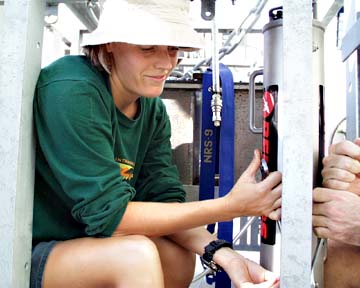
COURTESY PHOTO
Researchers took more than 30,000 photographs of the sea floor off Costa Rica to help explain apparent holes in hardened lava on the sea floor. The effort helped confirm a theory offered in 1999 by UH graduate student Jennifer Engels, above.
UH crew helps explain
underwater lava holesWorking with other experts,
UH scientists analyze deep-ocean
evidence for clues
University of Hawaii researchers and associates say they have found evidence to explain apparent holes in hardened lava on the floor of the deep ocean, a mystery that has eluded experts since the 1970s.
In a recent article in the journal Nature, they said lava erupting into cold sea water is causing the water to boil, and pockets of gas are causing the so-called collapse pits.
The new information has broad ramifications for volcanology and chemistry, changing how scientists look at lava, the sea floor and plate tectonics, said UH-Manoa graduate student Jennifer Engels.
Engels said research for her master's degree in 1999 showed that it was possible for sea water to boil under the huge pressure of ocean flowing over the lava.
Engels researched the collapse pits with her adviser, Margo Edwards, professor and director of the Hawaii Mapping Research Group in the Department of Geology and Geophysics; Michael Perfit, of the University of Florida; Johnson Cann, University of Leeds; Daniel Fornari and Deborah Smith, of Woods Hole Oceanographic Institution; and Ian Ridley, U.S. Geological Survey.
Their first research cruise was in February 2000 on the Woods Hole ship Atlantis at the East Pacific Rise, a midocean ridge west of Costa Rica where volcanic activity is forming new crust.
Engels said they took 30,000 photographs of the sea floor with a camera mounted on a special sled towed behind the ship. They lost the $250,000 camera in a collapse pit during a subsequent cruise, she said.
The Woods Hole submersible Alvin was used for another project, but some of the video footage provided additional data for her study, she said.
She did a detailed analysis of the size and locations of the pits, which she said cover about 13 percent of the surface of the sea floor.
"We have a better sense of how pervasive they are," she said.
From videos of the Big Island, she said, "It looks like a bubble gum bubble flowing up from the lava lake, but on a scale of 2 meters (6.6 feet) across."
Similarly at the East Pacific Rise, the researchers found "bubbles of vaporized sea water often rise through the base of lava flows and collect beneath the chilled upper crust.
"These bubbles of steam at magmatic temperatures may interact both chemically and physically with flowing lava, which could influence our understanding of deep sea volcanic processes and oceanic crustal construction more generally," they reported in Nature.
The most compelling evidence, Edwards said, was the "bubble-like shape in the lava and the very top had a hole punched in it like an air pocket."
Based on that, Engels began analyzing lava pieces collected from the sea floor. The surface appeared to be smooth and glassy, but she found textures on the surface that she said can only form in contact with boiling water.
Engels said the smallest collapse features are inches deep, and the largest ones are up to 82 feet deep.
